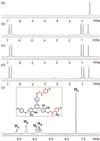Designed post-self-assembly structural and functional modifications of a truncated tetrahedron
- PMID: 21973048
- PMCID: PMC3212848
- DOI: 10.1021/ja207217t
Designed post-self-assembly structural and functional modifications of a truncated tetrahedron
Abstract
Post-self-assembly modifications of a discrete metal-organic supramolecular structure have been developed. Such modifications allow the properties of the self-assembled supramolecular species to be changed in a simple and efficient manner (>90% yield). Initiated by the application of chemical stimuli, the post-self-assembly modifications described herein result in three distinct changes to the supramolecular system: an individual building-block component change, an overall structural modification, and a functional evolution of a [6+4] metal-organic supramolecular structure. The three modifications have been carefully examined by a range of characterization methods, including NMR and UV-vis spectroscopy, electrospray ionization mass spectrometry, pulsed field gradient spin echo NMR measurements, electrochemical analysis, and computational simulations.
Figures















Similar articles
-
Coordination-driven self-assembly of three-dimensional supramolecular dendrimers.Inorg Chem. 2010 Jun 7;49(11):4747-9. doi: 10.1021/ic100330c. Inorg Chem. 2010. PMID: 20443570 Free PMC article.
-
Coordination-driven self-assembly of truncated tetrahedra capable of encapsulating 1,3,5-triphenylbenzene.Inorg Chem. 2010 Nov 15;49(22):10238-40. doi: 10.1021/ic1018373. Epub 2010 Oct 15. Inorg Chem. 2010. PMID: 20949905 Free PMC article.
-
Self-assembly, host-guest chemistry, and photophysical properties of subphthalocyanine-based metallosupramolecular capsules.J Am Chem Soc. 2013 Jul 17;135(28):10503-11. doi: 10.1021/ja404234n. Epub 2013 Jul 3. J Am Chem Soc. 2013. PMID: 23763242
-
Locking self-assembly: strategies and outcomes.Chem Soc Rev. 2007 Jun;36(6):856-68. doi: 10.1039/b415246h. Epub 2007 Feb 15. Chem Soc Rev. 2007. PMID: 17534473 Review.
-
Coordination-driven self-assembly of functionalized supramolecular metallacycles.Chem Commun (Camb). 2008 Dec 7;(45):5896-908. doi: 10.1039/b811712h. Epub 2008 Sep 1. Chem Commun (Camb). 2008. PMID: 19030534 Free PMC article. Review.
Cited by
-
Temperature Controls Guest Uptake and Release from Zn4L4 Tetrahedra.J Am Chem Soc. 2019 Sep 18;141(37):14534-14538. doi: 10.1021/jacs.9b07307. Epub 2019 Sep 9. J Am Chem Soc. 2019. PMID: 31478658 Free PMC article.
-
Pt(ii)-coordinated tricomponent self-assemblies of tetrapyridyl porphyrin and dicarboxylate ligands: are they 3D prisms or 2D bow-ties?Chem Sci. 2022 Mar 9;13(14):4070-4081. doi: 10.1039/d1sc06533e. eCollection 2022 Apr 6. Chem Sci. 2022. PMID: 35440981 Free PMC article.
-
Probing the Dynamics of the Imine-Based Pentafoil Knot and Pentameric Circular Helicate Assembly.J Am Chem Soc. 2019 Feb 27;141(8):3605-3612. doi: 10.1021/jacs.8b12800. Epub 2019 Feb 14. J Am Chem Soc. 2019. PMID: 30707020 Free PMC article.
-
Subcomponent Exchange Transforms an FeII4L4 Cage from High- to Low-Spin, Switching Guest Release in a Two-Cage System.J Am Chem Soc. 2017 May 10;139(18):6294-6297. doi: 10.1021/jacs.7b01478. Epub 2017 Apr 26. J Am Chem Soc. 2017. PMID: 28426930 Free PMC article.
-
Metal-organic frameworks and self-assembled supramolecular coordination complexes: comparing and contrasting the design, synthesis, and functionality of metal-organic materials.Chem Rev. 2013 Jan 9;113(1):734-77. doi: 10.1021/cr3002824. Epub 2012 Nov 2. Chem Rev. 2013. PMID: 23121121 Free PMC article. Review. No abstract available.
References
-
- Stang PJ, Olenyuk B. Acc. Chem. Res. 1997;30:502.
- Leininger S, Olenyuk B, Stang PJ. Chem. Rev. 2000;100:853. - PubMed
- Fujita M, Umemoto K, Yoshizawa M, Fujita N, Kusukawa T, Biradha K. Chem. Commun. 2001:509.
- Holliday BJ, Mirkin CA. Angew. Chem., Int. Ed. 2001;40:2022. - PubMed
- Seidel SR, Stang PJ. Acc. Chem. Res. 2002;35:972. - PubMed
- Fujita M, Tominaga M, Hori A, Therrien B. Acc. Chem. Res. 2005;38:369. - PubMed
- Pitt MA, Johnson DW. Chem. Soc. Rev. 2007;36:1441. - PubMed
- Lee SJ, Lin W. Acc. Chem. Res. 2008;41:521. - PubMed
- De S, Mahata K, Schmittel M. Chem. Soc. Rev. 2010;39:1555. - PubMed
- Nitschke JR. Acc. Chem. Res. 2007;40:103. - PubMed
- Oliveri CG, Ulmann PA, Wiester MJ, Mirkin CA. Acc. Chem. Res. 2008;41:1618. - PMC - PubMed
- Jin P, Dalgarno SJ, Atwood JL. Coord. Chem. Rev. 2010;254:1760.
- Caulder DL, Raymond KN. Acc. Chem. Res. 1999;32:975.
- Northrop BH, Zheng Y-R, Chi K-W, Stang PJ. Acc. Chem. Res. 2009;42:1554. - PMC - PubMed
- Chakrabarty R, Mukherhee PS, Stang PJ. Chem. Rev. 2011 Article ASAP. - PMC - PubMed
-
- Klosterman JK, Yamauchi Y, Fujita M. Chem. Soc. Rev. 2009;38:1714. - PubMed
- Pluth MD, Bergman RG, Raymond KN. Acc. Chem. Res. 2009;42:1650. - PubMed
- Yoshizawa M, Klosterman JK, Fujita M. Angew. Chem., Int. Ed. 2009;48:3418. - PubMed
- Yamauchi Y, Fujita M. Chem. Commun. 2010;46:5897. - PubMed
- Pluth MD, Bergman RG, Raymond KN. J. Am. Chem. Soc. 2008;130:6362. - PubMed
- Sawada T, Fujita M. J. Am. Chem. Soc. 2010;132:7194. - PubMed
- Pluth MD, Fiedler D, Mugridge JS, Bergman RG, Raymond KN. Proc. Natl. Acad. Sci. U. S. A. 2009;106:10438. - PMC - PubMed
- Mal P, Breiner B, Rissanen K, Nitschke JR. Science. 2009;324:1697. - PubMed
- Pluth MD, Bergman RG, Raymond KN. Science. 2007;316:85. - PubMed
- Sato S, Iida J, Suzuki K, Kawano M, Ozeki T, Fujita M. Science. 2006;313:1273. - PubMed
- Yoshizawa M, Tamura M, Fujita M. Science. 2006;312:251. - PubMed
- Northrop BH, Yang H-B, Stang PJ. Chem. Commun. 2008:5896. - PMC - PubMed
-
- Lehn J-M. Science. 2002;295:2400. - PubMed
- Fujii S, Lehn J-M. Angew. Chem., Int. Ed. 2009;48:7635. - PubMed
- Lao LL, Schmitt J-L, Lehn J-M. Chem.--Eur. J. 2010;16:4903. - PubMed
- Ramstrom O, Lehn J-M. Nat. Rev. Drug Discovery. 2002;1:26. - PubMed
- Lehn J-M. Proc. Natl. Acad. Sci. U. S. A. 2002;99:4763. - PMC - PubMed
- Lehn J-M, Eliseev AV. Science. 2001;291:2331. - PubMed
-
- Rowan SJ, Cantrill SJ, Cousins GRL, Sanders JKM, Stoddart JF. Angew. Chem., Int. Ed. 2002;41:899. - PubMed
- Corbett PT, Leclaire J, Vial L, West KR, Wietor J-L, Sanders JKM, Otto S. Chem. Rev. 2006;106:3652. - PubMed
- Cousins GRL, Poulsen S-A, Sanders JKM. Curr. Opin. Chem. Biol. 2000;4:270. - PubMed
- Otto S, Furlan RLE, Sanders JKM. Curr. Opin. Chem. Biol. 2002;6:321. - PubMed
Publication types
MeSH terms
Substances
Grants and funding
LinkOut - more resources
Full Text Sources

